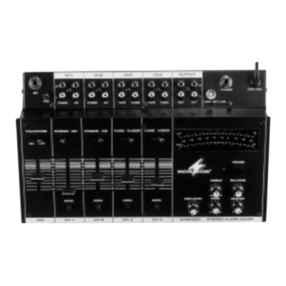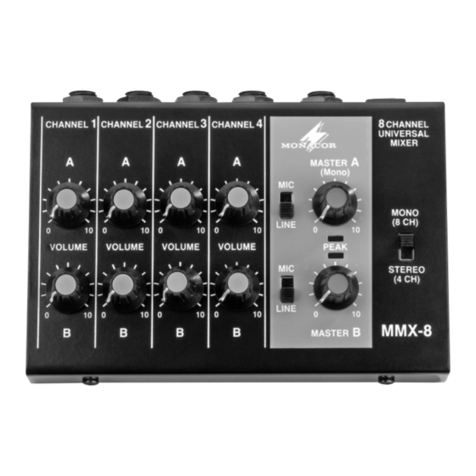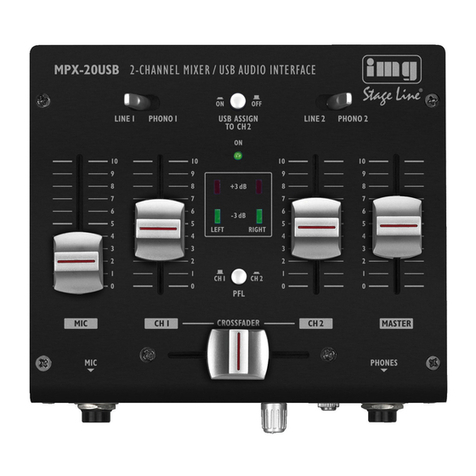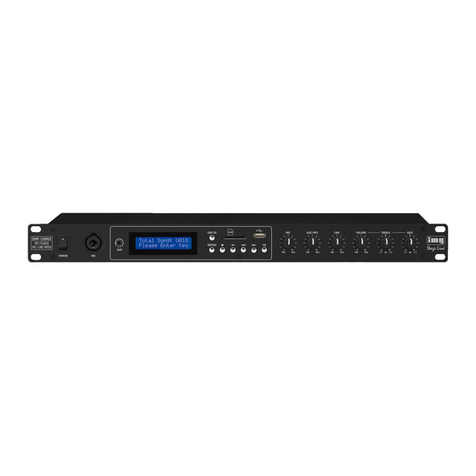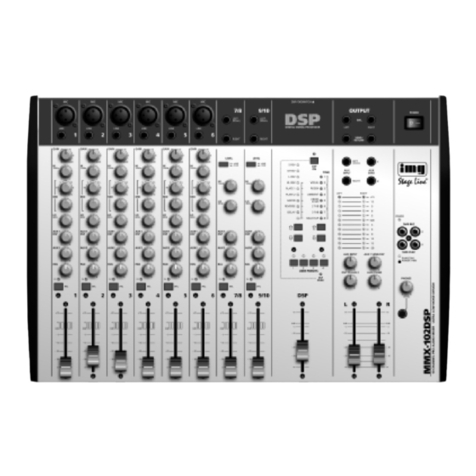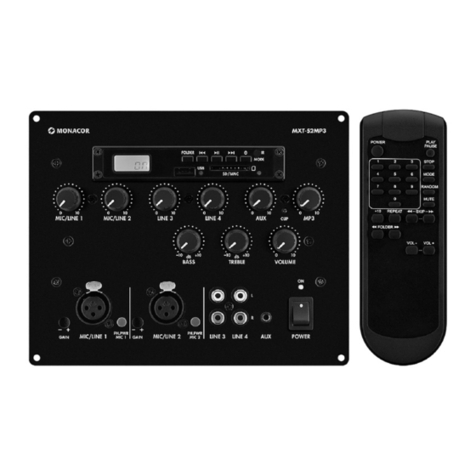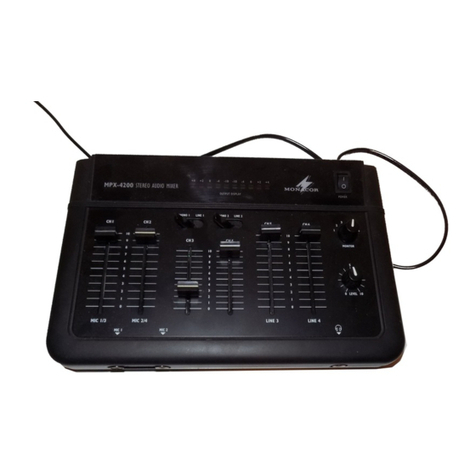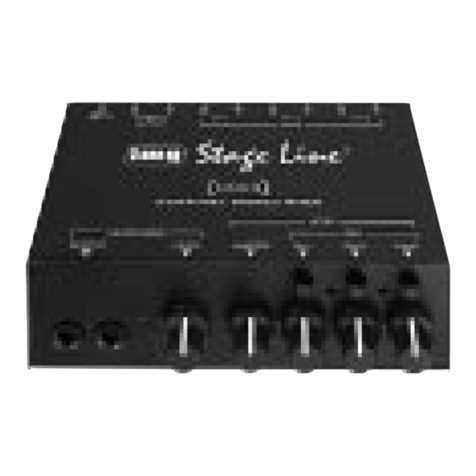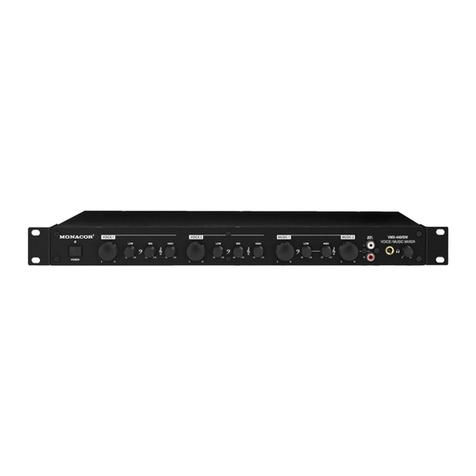4) Für Aufnahmezwecke steht bei beiden Beschal-
lungszonen ZONE1 und ZONE2 jeweils ein Ste-
reo-Ausgang als Cinch-Buchsenpaar zur Verfü-
gung; hier liegt immer das Mischsignal der
jeweiligen Zone in Stereo und unabhängig von
der Einstellung desAusgangslautstärkereglers an.
Anstelle von Aufnahmegeräten können auch
andere nachfolgende Geräte mit Line-Eingangs-
pegel an die Ausgänge angeschlossen werden,
z.B. ein zweites Mischpult.
5) An die 6,3-mm-Klinkenbuchse PHONES (4) kann
ein Stereo-Kopfhörer (Impedanz min. 32Ω)
angeschlossen werden, zum Vorhören der Ein-
gangskanäle CH1–CH4 oder zum Abhören der
beiden Ausgangskanäle vor den Lautstärkereg-
lern (22).
6) Zur Pultbeleuchtung kann eine Schwanenhals-
leuchte (12V, max. 5W) an die BNC-Buchse
LAMP (1) angeschlossen werden, z.B. die Leuch-
te GNL-205 aus dem Programm von „img Stage
Line“. Die Leuchte wird mit dem Mischpult ein-
und ausgeschaltet.
7) Zuletzt den Stecker des Netzkabels (23) in eine
Steckdose (230V~/50Hz) stecken.
5Bedienung
Vor dem Einschalten die Lautstärkeregler der Aus-
gangskanäle (22) auf Minimum stellen, um Ein-
schaltgeräusche zu vermeiden. Das Mischpult mit
dem Schalter POWER (2) einschalten. Die Betriebs-
anzeige darüber leuchtet.
Nach dem Betrieb das Mischpult wieder mit dem
Schalter POWER ausschalten.
5.1 Grundeinstellung der Eingangskanäle
Vorab alle Gain-Regler (9) auf Linksanschlag sowie
alle Klangregler (8) in die Mittelposition drehen.
Wird ein Eingangskanal CH1–CH4 nicht be-
nutzt, seinen Lautstärkeregler (15) auf Minimum
stellen. Wird der Mikrofonkanal MIC nicht genutzt,
zum Ausschalten des Mikrofons den Schalter (5) in
Position OFF stellen.
5.1.1 Eingangskanäle CH1–CH4 aussteuern
Zum Aussteuern eines Eingangskanals:
1) Mit dem Eingangsumschalter (10) des Kanals die
gewünschte Tonquelle anwählen.
2) Ein Tonsignal (z.B. Musikstück) auf den Eingang
geben; bei Anschluss eines Mikrofons in das
Mikrofon sprechen.
3) Den GAIN-Regler (9) am Eingangskanal mithilfe
eines Schraubendrehers so einstellen, dass bei
durchschnittlich lauten Passagen die LED
PEAK/SIGNAL (11) grün und nur gelegentlich,
bei Pegelspitzen, rot aufleuchtet. Leuchtet die
LED häufiger rot, ist der Kanal übersteuert. In die-
sem Fall den GAIN-Regler wieder etwas zurück-
drehen oder den Ausgangspegel der jeweiligen
Tonquelle reduzieren bzw. den Abstand zum
Mikrofon vergrößern.
5.1.2 Mikrofonkanal MIC aussteuern
1) Zum Einschalten des Mikrofons den Schalter (5)
in Position ON AIR stellen.
2) In das Mikrofon sprechen. Den GAIN-Regler (9)
am Mikrofonkanal so einstellen, dass bei durch-
schnittlich lauter Sprache die LED PEAK/SIGNAL
(11) grün und nur gelegentlich, bei Pegelspitzen,
rot aufleuchtet. Leuchtet die LED häufiger rot, ist
der Kanal übersteuert. In diesem Fall den GAIN-
Regler wieder etwas zurückdrehen oder den
Abstand zum Mikrofon vergrößern.
Tritt eine akustische Rückkopplung auf (lauter
Pfeifton), den Lautstärkeregler (16) herunterzie-
hen.
3) Den Klang mit der 3fachen Klangregelung (8)
des Kanals einstellen. Zur Kontrolle sollte, wie in
Kapitel 5.2 beschrieben, der Mikrofonkanal
einem Ausgangskanal zugeordnet und der Laut-
stärkeregler (16) hochgeschoben sein, damit die
Klangänderung über die Verstärkeranlage oder
über einen Kopfhörer (→Kapitel 5.4) gehört wer-
den kann. Die Höhen (HIGH) und Bässe (LOW)
lassen sich bis max. 15dB anheben oder absen-
ken, die Mitten (MID) bis max. 12dB. Eventuell
danach die Eingangsverstärkung mit dem Gain-
Regler korrigieren.
5.2 Ausgangskanäle einstellen
1) Die Eingangskanäle jeweils mit den Tasten Z1
und Z2 (14) wie gewünscht den beiden Aus-
gangskanälen zuweisen:
Taste Z1 gedrückt:
Eingangskanal auf Kanal ZONE1 geschaltet
Taste Z2 gedrückt:
Eingangskanal auf Kanal ZONE2 geschaltet
2) Den Lautstärkeregler des gewünschten Ein-
gangskanals nach oben schieben. Sollen meh-
rere Tonquellen auf einen Ausgangskanal
gemischt werden, mit den Lautstärkereglern (15,
16) der entsprechenden Eingangskanäle das ge-
wünschte Lautstärkeverhältnis der Tonquellen un-
tereinander einstellen.
3) Jeden Ausgangskanal anhand seiner Pegelan-
zeige (19) mit seinem Lautstärkeregler (22) aus-
steuern. In der Regel wird eine optimaleAussteu-
erung erreicht, wenn die Pegelanzeige Werte im
0-dB-Bereich anzeigt. Ist der Ausgangspegel
jedoch für das nachfolgende Gerät zu hoch oder
zu niedrig, muss das Ausgangssignal entspre-
chend niedriger oder höher ausgesteuert wer-
den. Leuchtet die rote LED „+9“, ist der Ausgang
übersteuert. In diesem Fall den Regler entspre-
chend herunterziehen. Die Signale an den Auf-
VORSICHT Stellen Sie die Lautstärke der Audio-
anlage und die Kopfhörerlautstärke
nie sehr hoch ein. Hohe Lautstärken
können auf Dauer das Gehör schä-
digen! Das menschliche Ohr gewöhnt
sich an hohe Lautstärken und empfin-
det sie nach einiger Zeit als nicht
mehr so hoch. Darum eine hohe Laut-
stärke nach der Gewöhnung nicht
weiter erhöhen.
ZONE2: a balanced XLR output (26) and an
unbalanced phono output (27).
Instead of amplifiers, it is also possible to
connect other following units with line input level
to the outputs, e.g. a second mixer.
4) For recording purposes a stereo output each for
the two PA zones ZONE1 and ZONE2 is availa-
ble as pair of phono jacks; here the mixed signal
of the corresponding zone is always available in
stereo and independent of the adjustment of the
output fader.
Instead of recorders, it is also possible to
connect other following units with line input level
to the outputs, e.g. a second mixer.
5) It is possible to connect to the 6.3 mm jack
PHONES (4) stereo headphones (minimum im-
pedance 32Ω) for pre-fader listening to the input
channels CH1 to CH4 or for monitoring the two
output channels ahead of the faders (22).
6) For illuminating the console, a gooseneck light
(12V, max. 5W) may be connected to the BNC
jack LAMP (1), e.g. the light GNL-205 from the
product range of “img Stage Line”. The light is
switched on and off with the mixer.
7) Finally connect the plug of the mains cable (23)
to a socket (230V~/50Hz).
5Operation
Prior to switching on, set the faders of the output
channels (22) to minimum to prevent switching
noise. Switch on the mixer with the POWER switch
(2). The power LED above it lights up.
After the operation switch off the mixer with the
POWER switch.
5.1 Basic adjustment of the input channels
First set all gain controls (9) to the left stop and all
equalizers (8) to mid-position.
If an input channel CH1 to CH4 is not used, set its
fader (15) to minimum. If the microphone channel
MIC is not used, set the switch (5) to position OFF
for switching off the microphone.
5.1.1 Level control of the input channels CH1 to
CH4
For level control of an input channel:
1) Use the input selector switch (10) of the channel
to select the desired audio source.
2) Feed an audio signal (e.g. music piece) to the
input; with connection of a microphone, talk into
the microphone.
3) Adjust the GAIN control (9) at the input channel
by means of a screwdriver in such a way that the
LED PEAK/SIGNAL (11) shows green at aver-
age volume and only occasionally shows red at
level peaks. If the LED shows red more fre-
quently, the channel is overloaded. In this case
slightly turn back the GAIN control or reduce the
output level of the corresponding audio source or
increase the distance to the microphone.
5.1.2 Level control of the microphone channel
MIC
1) To switch on the microphone, set the switch (5) to
position ON AIR.
2) Talk into the microphone.Adjust the GAIN control
(9) of the microphone channel in such a way that
the LED PEAK/SIGNAL (11) shows green at
average speech volume and only occasionally
shows red at level peaks. If the LED shows red
more frequently, the channel is overloaded. In
this case slightly turn back the GAIN control or
increase the distance to the microphone.
In case of a howlback (loud whistling), adjust
the fader (16) downward.
3) Adjust the sound with the 3-way equalizer (8) of
the channel. For a check, as described in chapter
5.2, the microphone channel should be assigned
to an output channel and the fader should be
advanced (16) so that the change of sound can
be heard via the amplifier system or via head-
phones (→chapter 5.4). The HIGH frequencies
and LOW frequencies can be boosted or attenu-
ated up to 15dB as a maximum, the MID fre-
quencies up to 12dB as a maximum. If required,
readjust the input amplification with the gain
control.
5.2 Adjustment of the output channels
1) Assign the input channels with the buttons Z1
and Z2 (14) respectively to the two output chan-
nels as desired:
button Z1 pressed:
input channel switched to channel ZONE1
button Z2 pressed:
input channel switched to channel ZONE2
2) Advance the fader of the desired input channel.
For mixing several audio sources to one output
channel, adjust the desired volume ratio of the
audio sources to one another with the faders (15,
16) of the corresponding input channels.
3) Control the level of each output channel by
means of its level indication (19) with its fader
(22). In general, an optimum level is obtained
when the level indication displays values in the
0dB range. However, if the output level is too
high or too low for the following unit, the output
signal must be controlled to a correspondingly
lower or higher level. If the red LED „+9“ lights up,
the output is overloaded. In this case adjust the
fader downward accordingly. The signals at the
recording outputs REC (28) are independent of
the volume adjustment of the output channels.
CAUTION Never adjust the audio system or the
headphones to a very high volume.
Permanent high volumes may
damage your hearing! The human ear
will get accustomed to high volumes
which do not seem to be that high
after some time. Therefore, do not fur-
ther increase a high volume after get-
ting used to it.
6
GB
D
A
CH
